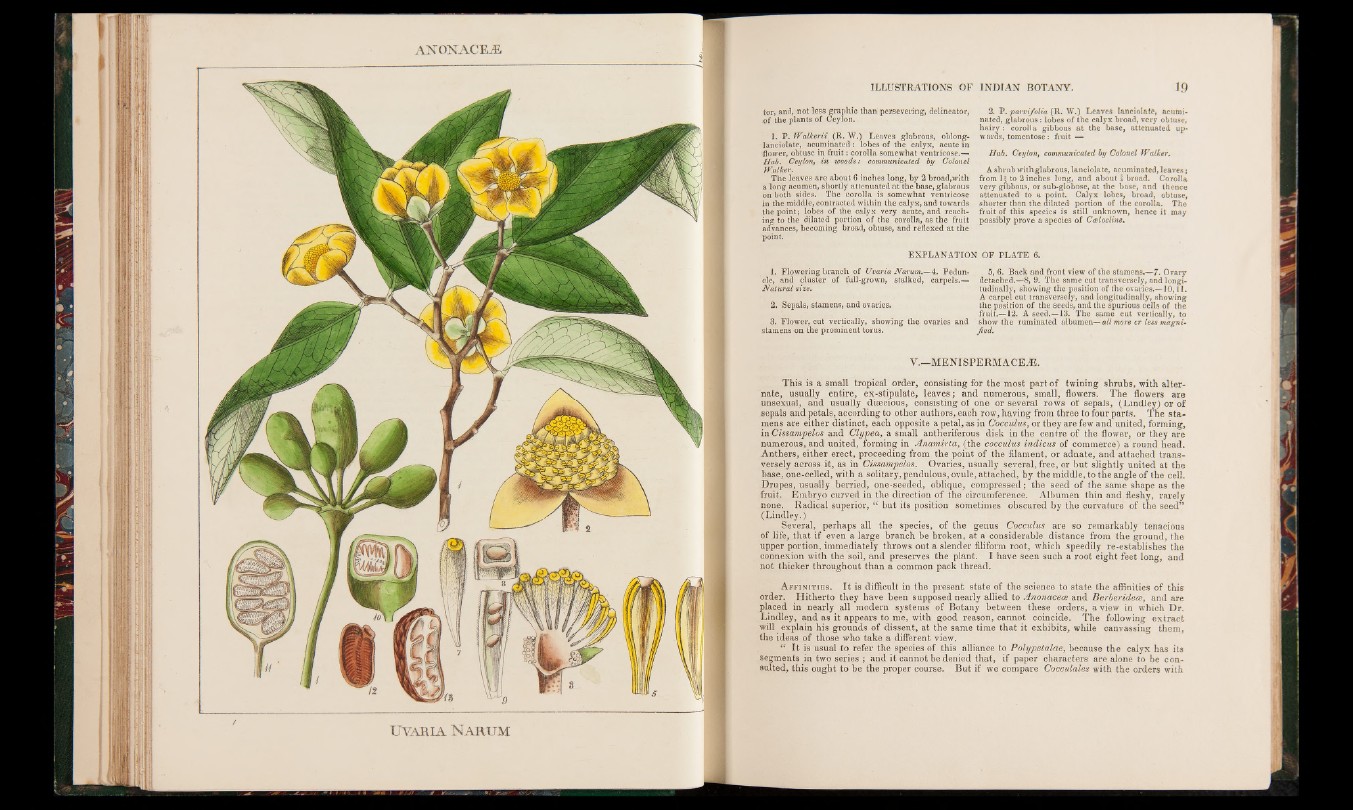
ANONACEÆ
Uyahia Na r um
tor, and, not less graphic than persevering, delineator,
of the plants of Ceylon.
1. P. Wa lke rii (R. W.) Leaves glabrous, oblong-
lanciolate, acuminated: lobes of the calyx, acute in
flower, obtuse in fruit: corolla somewhat ventricose.—
Hab. Ceylon, in woods: communicated by Colonel
Walker.
The leaves are about 6 inches long, by 2 broad,with
a long acumen, shortly attenuated at the base, glabrous
on both sides. The corolla is somewhat ventricose
in the middle, contracted within the calyx, and towards
the point; lobes of the calyx very acute, and reaching
to the dilated portion of the corolla, as the fruit
advances, becoming broad, obtuse, and reflexed at the
point.
2. P. parvi/olia (R. W.) Leaves lanciolate, acuminated,
glabrous: lobes of the calyx broad, very obtuse,
hairy : corolla gibbous at the base, attenuated upwards,
tomentose: fruit —
Hab. Ceylon, communicated by Colonel Walker.
A shrub with glabrous, lanciolate, acuminated, leaves;
from 11 to 2 inches long, and about I broad. Corolla
very gibbous, or sub-globose, at the base, and thence
attenuated to a point. Calyx lobes, broad, obtuse,
shorter than the dilated portion of the corolla. The
fruit of this species is still unknown, hence it may
possibly prove a species of C(Blocline.
EXPLANATION OP PLATE 6.
1. Flowering branch of Uvaria Narum.—4. Peduncle,
and cluster of full-grown, stalked, carpels.—
N a tu ra l size.
2. Sepals, stamens, and ovaries.
3. Flower, cut vertically, showing the ovaries and
stamens on the prominent torus.
5, 6. Back and front view of the stamens.—7. Ovary
detached.—8, 9. The same cut transversely, and longitudinally,
showing the position of the ovaries.—10,11.
A carpel cut transversely, and longitudinally, showing
the position o f the seeds, and the spurious cells of the
fruit.—12. A seed.—13. The same cut vertically, to
show the ruminated albumen—all more cr less magnified.
V.—MENISPERMACEJ2.
This is a small tropical order, consisting for the most part of twining shrubs, with alternate,
usually entire, ex-stipulate, leaves; and numerous, small, flowers. The flowers are
unsexual, and usually disecious, consisting of one or several rows of sepals, (Lindley) or of
sepals and petals, according to other authors, each row, having from three to four parts. The stamens
are either distinct, each opposite a petal, as in Cocculus, or they are few and united, forming,
in Cissampelos and Clypea, a small antheriferous disk in the centre of the flower, or they are
numerous, and united, forming in Anamirta, (the cocculus indicus of commerce) a round head.
Anthers, either erect, proceeding from the point of the filament, or adnate, and attached transversely
across it, as in Cissampelos. Ovaries, usually several, free, or but slightly united at the
base, one-celled, with a solitary, pendulous, ovule, attached, by the middle, to the angle of the cell.
Drupes, usually berried, one-seeded, oblique, compressed; the seed of the same shape as the
fruit. Embryo curved in the direction of the circumference. Albumen thin and fleshy, rarely
none. Radical superior, “ but its position sometimes obscured by the curvature of the seed”
(Lindley.)
Several, perhaps all the species, of the genus Cocculus are so remarkably tenacious
of life, that if even a large branch be broken, at a considerable distance from the ground, the
upper portion, immediately throws out a slender filiform root, which speedily re-establishes the
connexion with the soil, and preserves the plant. I have seen such a root eight feet long, and
not thicker throughout than a common pack thread.
A f fin it ie s. It is difficult in the present state of the science to state the affinities of this
order. Hitherto they have been supposed nearly allied to Anonacece and Berberidece, and are
placed in nearly all modern systems of Botany between these orders, a view in which Dr.
Lindley, and as it appears to me, with good reason, cannot coincide. The following extract
will explain his grounds of dissent, at the same time that it exhibits, while canvassing them,
the ideas of those who take a different view.
“ It is usual to refer the species of this alliance to Polypetalae, because the calyx has its
segments in two series ; and it cannot be denied that, if paper characters are alone to be consulted,
this ought to be the proper course. But if we compare Cocculales with the orders with